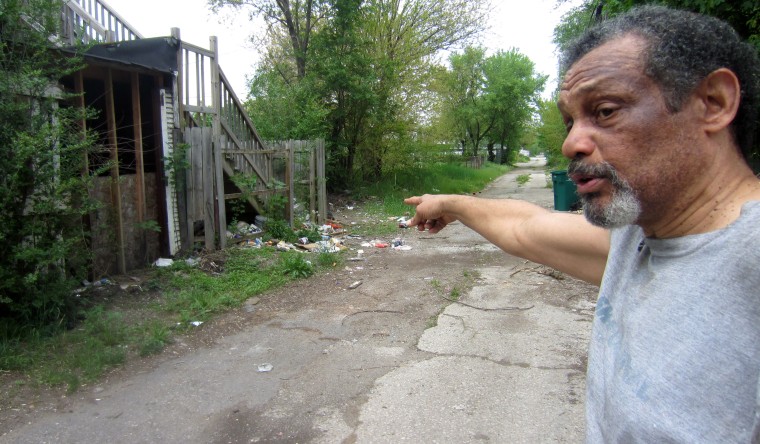GARY, Ind. -- No matter which direction Arthur Joe looks from his home, he sees abandoned properties and the blight they attract.
Next door is an empty house where “drugheads” – as Joe calls them – often set up camp. Behind is a duplex with trash visible through every broken window, and an alley clogged with refuse spilling from several abandoned lots.
Across the street is a vacant house owned by Joe’s landlord. Joe mows the grass there, vowing “we’re going to put it back together.”
For decades, Gary has been ravaged by economic decline and a long, deep housing bust, and putting it back together won’t be easy. Mayor Karen Freeman-Wilson thinks letting vast swaths of her once-prosperous city, the birthplace of Michael Jackson, return to nature might be a solution.
“I’d like to see 100,000 folks in Gary. That’d be great,” the mayor said recently, walking through a neighborhood where empty lots and structures outnumber occupied homes. “We could probably do it in 35 square miles.” That’s 25 percent more residents on nearly 40 percent less land.

Abandoned properties tear at a city’s social fabric. Vacant homes, empty lots and illegal dumps make remaining residents feel isolated, kill community spirit, and breed crime. Providing city services to largely-abandoned neighborhoods wreaks havoc on Gary’s budget.
“All those buildings represent the deterioration of Gary,” said former Chicago Mayor Richard M. Daley. “You have to get those down. If you don’t, that’s a symbol.”
Daley has been offering advice to Mayor Freeman-Wilson, and also the skills of public policy students he teaches at the University of Chicago.
“Neglect can lure criminals into neighborhoods that are normally safe,” observed grad student David Smith, one of about 20 students helping inventory abandoned properties in Gary on a recent Saturday.
Tracking the decay
They used a smartphone app to record answers to key questions: Is a structure occupied? Is it wood or brick? Is it secured? Is fire damage visible? Then they rank buildings with school-like grades, A to F.
There are a lot of D’s and F’s in Gary – homes barely standing, often open to the elements. They’re a reminder of what used to be. A city population that peaked at 180,000 in 1960 has fallen to about 80,000.
Named after a steel company president, Gary acutely suffered Big Steel’s decline. US Steel, for instance, once employed 25,000 people in its Gary operations; now only 5,000 locals work for that company. Median family income is $32,000, about half the national average. More than a third of Gary residents have incomes below the poverty line.
Gary is not only getting poorer— it’s getting older. “You can see it in the churches,” Mayor Freeman-Wilson said. Her own church, Israel CME, is in Midtown. She has fond memories of the days when the neighborhood was home to a thriving African-American middle class. Now she must figure out if it’s worth saving.
Lots of Rust Belt cities are making a priority of “urban removal.” In Detroit, a Blight Authority has been set up to speed demolition of abandoned structures. In Flint, Mich., a study found that $3.5 million spent on demolition raised the value of surrounding properties by $112 million.
Even though Gary’s redevelopment budget is almost entirely devoted to the task, it doesn’t have much money to demolish abandoned buildings. “We have to work smarter because we have so many limitations on resources,” the mayor said.
The housing inventory is a first step. The plan is to map the results and then overlay data about crime, city service calls, and infrastructure.
The results will help the city apply for grant money to do more demolitions and assist in deploying the Gary’s one-man board-up crew more efficiently, targeting neighborhoods where a single abandoned home may drag down the quality of life for residents who are maintaining their properties.
The city has other short-term fixes in mind— like a dollar-a-home fire sale.
$1 for a home
Redevelopment Director Joe Van Dyk figures 6,500 of the 7,000 properties the city owns – many of them for non-payment of taxes – are abandoned. Gary plans a dollar-a-home auction in the next few months, selling off dwellings needing $15,000-30,000 in repairs. Buyers would pledge to rehab their purchases quickly.
For buildings that can’t be restored easily, Gary officials have discussed a “deconstruction” program, hiring crews to disassemble buildings and recycle building materials. It might make removal of abandoned structures cheaper, and provide badly needed job opportunities.
But getting rid of blight is not easy. “Housing is very durable,” noted Professor Ben Keys of the Harris School of Public Policy at the University of Chicago, one of the volunteers helping with Gary’s housing census. “The solutions are either very harsh or very incremental.”
Giving up on entire neighborhoods and moving long-time residents to viable parts of the city will be harsh. City services would be cut off to moribund parts of town, though the city would retain ownership.
That’s critical, according to Daley: “Abandoned buildings are a liability. Land is always an asset.”
Freeman-Wilson and Daley are confident the city is headed for better days, given its transportation infrastructure, location on Lake Michigan waterfront and proximity to Chicago.
“This is solvable,” said Daley. “I see a great future for Gary.”
As Freeman-Wilson sent student volunteers out to quantify the blight that dominates her city, she had some parting words: “When you see Gary return, you’ll know you had a role.”
Related stories: